Pacific Rim: In-depth study of the influence of Anime
As an American born and raised in Japan in the 90’s, anime was a major source of entertainment. Hit Japanese animations such as Dragon Ball Z, Yu-Gi-Oh, Naruto, and – of course – Pokemon were as popular in Japanese culture as Marvel and D.C. are in America. Like many devoted enthusiasts of anime, when I heard about Pacific Rim last year I was naturally very excited.
In 2013, esteemed director Guillermo del Toro (GDT) excited thousands of anime fans with the announcement of his film, Pacific Rim. Best known for directing Hellboy (2004) and Pan’s Labryinth (2006), GDT brought to life an exciting, fresh film that Anime fanatics can only dream about: giant monsters fighting giant robots. The film instantly captured the hearts of people around the world, long before script had been translated to the screen.
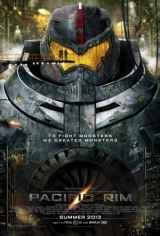
For those who have not kept up to date with action blockbusters, Pacific Rim takes place in a world not so different from our own. When legions of monstrous creatures, known as Kaiju, rise from the sea a war between humans and the Kaiju begin. To combat the giant Kaiju, a special type of massive robot weapon (mecha in anime) was devised: Jaegers. Two unlikely heroes- a washed up former pilot (Charlie Hunnam) and an untested trainee (Rinko Kikuchi) are teamed to drive a legendary but seemingly obsolete Jaeger from the past.
The blockbuster period where Pacific Rim was released has come and gone but the hype and rumors surrounding the film have not. Even though the film did not fair much greater than your typical action flick (7/10 on IMDB), between the mecha and kaiju, fans were quick to draw comparisons to Japanese pop culture. However, the film was not made with any intention of comparing with other films. GDT was quoted saying:
I felt there was a chance to do something fresh, something new that at the same time was conscious of the heritage, but not a pastiche or an homage or a greatest hits of everything. One of the first things I did is make it a point to not check any old movies or any other references. Like start from scratch. (Schaefer)
The amazing thing about Pacific Rim is when it came out last year anime fans were determined to compare the film with Neon Genesis Evangelion (NGE), one of the most well-known mecha anime of the 90’s. While it was exciting to have a live action film about the anime mecha (giant robot) genre that was not Transformers, the comparisons seems to have been taken to an extreme. Like with analysis of any creative work, speculation is nothing more than grasping at straws. Only by asking the production team will you know their intentions. Thankfully many interviewers did just that. Travis Beacham, the screenwriter says this:
I did love Evangelion very much, but I actually wrote most of Pacific Rim before I saw it. (Schaefer)
It is a note of extreme ignorance on the anime blogosphere’s part to assume that Evangelion was an influence on Pacific Rim just because it is a well-known title. For example, the articles by Tim Hornyak, Akyho, or Miss Booleana were written prior to published interviews with GDT about Pacific Rim.
Now that the bubble has burst, here is what Guillermo del Toro has to say about the comparisons to Evangelion:
I haven’t seen Evangelion. I accept you Patlabor, [as an influence] from anime industry, or, Tetsujin-28, I don’t have any problem saying ‘I love them’, ‘they’re an influence for me’. […] Yeah, there is anime influence [in Pacific Rim], but not from that anime in particular. (Schaefer)
Even though the movie may stand alone as unique to Western Culture, one cannot help but recognize the similarities between Pacific Rim and Japanese culture. Chuck Palahniuk, the author of Fight Club says: “That’s why I write, because life never works except in retrospect. You can’t control life, at least you can control your version”. What Palahniuk is trying to convey is that, in GDT’s case, one derives what they write about from their own experiences, whether it is conversations one’s heard or a television series one’s seen. Even if GDT made a conscious effort not to look back on “old movies” or other influences, at least if one follows Palahniuk’s philosophy, GDT was essentially creating his own version of his anime favorites through Pacific Rim.
Kaiju and Godzilla
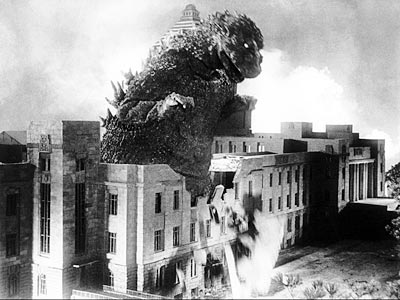
Although it is not an anime, Pacific Rim manages to take the classic, horror monster, Godzilla, and bring it to life in a fresh, new way. Godzilla is a daikaiju (‘strange monster’) that first appeared in Ishiro Honda’s 1954 film Godzilla. In fact, GDT had every intention of hailing to this type of monster. “The first notion was to inform the ideas with the tradition of the kaiju eiga [Japanese giant monster films]” (Lambie)
Godzilla was initially created in light of the bombing of Hiroshima and Nagasaki during World War II. The creature was born from the radiation caused by the explosion and rose from the sea. Godzilla then proceeds to wreak havoc across Tokyo and takes the lives of hundreds upon thousands of Japanese people. The creature both serves as a representation of fear over nuclear technology, and a metaphor for the destruction the nuclear bomb caused.
The Kaiju’s origins are very similar to Godzilla’s. Raleigh Beckett (Charlie Hunnam) states that “when alien life entered our world, it was from deep beneath the Pacific Ocean. A fissure between two tectonic plates.” While rising from the ocean is not enough of a parallel, GDT still alludes to the damaging trauma caused by the daikaiju during Mako’s flashback in the drift.
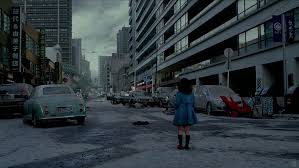
GDT continues to pay homage to the kaiju eja in designing the Kaiju. When coming up with initial designs, he wanted to focus on the silhouettes of their shapes. He wanted to preserve “the basic proportions of a man in a suit for the monsters” which is a technique used to create Godzilla in the original film. He also recognizes that, “in the traditional kaiju eiga, it’s easy to read the silhouettes – it’s one of the unique things about those kinds of monsters” (Lambie).
Yet, even with allusions to the techniques and themes of the kaiju eiga, GDT was very careful to create monsters that are entirely new.
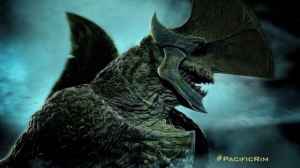
When detailing the monsters, I had the team reference real things, like in National Geographic, for example, the profile of a goblin shark, the skin of an elephant – but not reference, ever, other movie monsters (Lambie)
Pacific Rim certainly delivers with its unique range of creatures with differing abilities and their destructive capabilities.
Godzilla is a creature that has often been recreated and presented in different ways throughout the years. This coming May, we will see Godzilla revamped again, presumably in a way that matches the destructive capabilities of the Kaiju. However, unlike Pacific Rim, humanity has little hope of victory.
What sets Pacific Rim apart from Godzilla is genre. As a modern-day horror film, humanity is not meant to stand up to, and eventually defeat, the kaiju eiga. However, the action film genre gives everyone a fighting chance. In the face of overwhelming circumstances, and with undeniable casualties, the monsters are defeated by the hope given to the people. In Pacific Rim, this hope is given shape in the form of mechas.
The Mecha Genre
The introduction of the mechs to Pacific Rim as a fighting force hails to Japan’s modern-day sentiments about technology. While the kaiju eiga, Godzilla, was a product of – and warning against – nuclear technology, humanity uses nuclear energy to save the world in Pacific Rim. The original Jaeger technology is nuclear powered and it is this technology that eventually saves humanity. In the years following Godzilla, Japan has taken a very pro-technology stance. Pacific Rim – and the mecha genre as a whole – take a stand in honor of technology. Travis Beacham is quoted saying:
Look, Japan loves its mecha. It doesn’t have the technological warning of Frankenstein. (Lambie)
It is important to understand what the mecha genre entails if one wants to explore this concept. The “mecha” aspect of the genre is simply the word that references the robots present in the anime, although the mecha anime themselves are usually a part of a project with multiple genres attached to it. Romance, drama, comedy, and science fiction are common extra genres paired with mecha. Sometimes a show comes along which tries to contain elements of all these aspects, which have a variety of results. This genre of anime has been divided into two sections.
Super Robot Anime
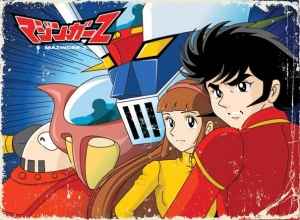
Mazinger Z is considered the beginnings of the super robot genre, and changed the face of mecha anime forever. It was the first anime that allowed the main character to pilot the robot from inside. Like GDT, the author of the original 1972 manga Go Nagai (Cutie Honey) was inspired by Tetsujin-28. The title character is the robot itself. It was created by forging new metals found at the top of Mount Fuji together. It was the first mecha anime to include the shouting out of attack names and many of the features which make up the super robot genre: playing an invincible dues ex machine role and combining with other robots to create bigger, more invincible, ridiculous looking creations (think Power Rangers).
The stories, like this one, have a large episode count which are usually episodic and have ‘monster of the week’ themes, of course, with an overarching story. The enemies are also usually not human. Does Pacific Rim utilize elements of the Super Robot genre? Only for about two minutes.
There is a scene near the end where multiple teams of pilots group together to fight one kaiju. One group in particular seem to have devised their own set of attacks. The fact that the enemies are from another universe and are alien creatures may also be a similarity to the super robot genre
By being influenced by Tetsujin-28 GDT was unintentionally being influenced by this title as well, since all mecha anime sprouted from the same seed. Might you have seen it before? In the same year the Mazinga Z comic was adapted to a 92 episode anime. It was broadcast in America in 1985 under the name: Tranzor Z. The character names were changed and only 65 of the original episodes were aired. In the opening sequence the same animation was used although the instrumental version for the song lays underneath a stupid, corny narration – please take a look if you would like a laugh.
It also became a big hit in Mexico in 1980’s, although they were fortunate enough to not have an edited version. Since its original publication the series has branched into a multitude of spin offs, including an alternate retelling of the series made in 2009 called Shin Mazinger Shogeki! Z Hen. The series appears to have kept the integrity of the simplistic character and mechanical designs, just boosted up the animation quality, lighting and detail in the background art. Since it has not yet been licensed it is currently available via the stream.
Below I have the original Japanese opening. As someone who wasn’t even alive in 1985 I can safely say this is the superior version – sorry nostalgia junkies.
In the US you may be familiar with the Super Robot genre with Voltron (1984), made up of the heavily edited Japanese series Armored Fleet Dairugger XV and Beast King GoLion. More recently the super robot genre returned with critically acclaimed Tengen Toppa Gurren Lagann (2007) which you are very likely to be able to find in your DVD stores today.
Real Robot
The real robot genre tries to approach the mecha genre from a more down-to-earth standpoint. What would the physics and rules be involved with machines like these? The robots are more likely to use ranged weapons rather than random superpowers and tend to be focused more on an overarching story than a ‘monster of the week’ format. Mobile Suit Gundam (1979) which will be mentioned below, is largely credited with starting this style of mecha anime, and one of the influences that GDT has mentioned. The other anime known to be major influence to this section of mecha anime is 36 episode Super Dimension Fortress Macross (1982), otherwise known as the Macross Saga of the popular Robotech series.
Compared to today’s standards the animation for Macross is cringe worthy and awful, but the soundtrack and characters stand up. The story would be nothing without the memorable characters to pull it along, as the series is mostly episodic. It does contain a lot in common with Voltron in the sense that it involves a bunch of aliens attacking the main characters. With the exception of interludes of character development via flashbacks and the like, the story does not show its true colours until about two thirds of the way through. Sadly, the series has been out of print for some time. The last printed DVDs, in Australia anyway, were an uncut 2002 release.
Here’s a re-animated version of the catchy-as-hell opening song that was released with the 2012 Blu Rays in Japan. If only the entire series could have been redone!
Pacific Rim ultimately has more involvement with the Real Robot subgenre then the Super Robot one as normal physics apply. The film is considered a science fiction action, rather than a fantastical action film. The Jeagers often get damaged or knocked out completely. With a stronger understanding of the origins of the mecha genre, we can now take a look at the anime that GDT has mentioned are inspirations to his work.
Mecha Anime that Inspired Pacific Rim
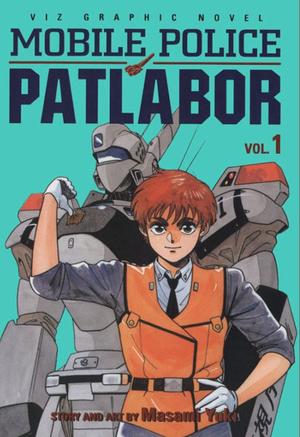
Patlabor is one of those shows which is so old we’re already past the “future” it’s set in. In some ways, the only way we are different from this universe is the use of the robots themselves. Clocking in at a total of 63 episodes, Patlabor takes place between 1998 and 2002. Robots called “Labors” are employed in heavy construction work. The Tokyo Metropolitan Police has its own fleet of Patrol Labors or “Patlabors” to combat crime and deal with accidents involving Labors.
The story arcs usually revolve around Tokyo Metropolitan Police Special Vehicle Section 2. Noa Izumi is the main protagonist of the series, but the series alternates between different characters – the adults and the young adults.
Sunrise produced a seven part OVA series (1993) that links onto the timeline of two of its movies. The manga also followed its own timeline. Even though the series debut was in 1989 critics at The Nihon Review and Anime News Network have praised it for its interesting, albeit slow story and strong characterization. The OVA’s and the second movie made it into Justin Sevakis’s “Top 10 Anime from the 90’s” List on Anime News Network’s podcast from 2012. Patlabor has a vast universe of stories to explore for those who are willing, and GTD is certainly not the only one whom keeps it close to his heart. A live action film adaption of the hit television series is due to hit Japan in 2015.
It seems that GDT did not lift much material from Patlabor. One important person in the vast world of mecha is the work of Yutaka Izubuchi. Besides being the creative designer of the Patlabors, he was responsible for the mechanical designs for the following projects: Aura Battle Dubine (1983), Assemble Insert (1989), Mobile Suit Gundam ZZ (1986). Armored Trooper Votoms: The Heretic Saint (1994), Gundam Build Fighters (2014). This list is by no means exhaustive, but it can give us a good idea of the variety of mecha designs – so similar and yet so different!
While a lot of older television series seem to have incorporated a superhero trope with a cape and sword, the Patlabor designs in particular share some similar design qualities with the Jaegers from Pacific Rim. The only differences, at least with this model of Patlabor, is that the Jaegers do not have painted plates, are smoother and more rounded, and do not have those weird rectangular ‘ears’ pointing out of the head. If nothing else, the work of Izubuchi proves that even though it’s easy to point out similarities between mechanical designs, that none will completely match the other. The man is truly a great artist, as he has contributed other talents such as screenwriting, costume design and directing to other projects. He worked with other design elements of Evangelion 3.0, Eureka Seven as is credited as the main creator of Rahxephon.
Tetsujin-28
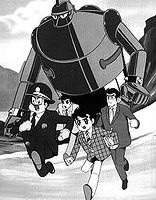
Credited as one of the first, if not the first, mecha anime ever brought to television, Tetsujin-28 (Iron man #28) is a 1956 manga written and illustrated by Mitsuteru Yokoyama. The series takes place during the final days of World War II when Shotaro Kaneda, ten-year old boy detective, is given his late father’s creation: Tetsujin-28. The three-story high, remote-controlled robot was an obsolete, unused military tool that Shotaro used to stop criminals and enemy robots.
The original anime was a lighthearted adventure tale, but the 2004 reboot explored the horrors of World War II.
The author noted that his works were heavily influenced by his own experiences during World War II; notably, the bombing of Kobe. He wrote about it in Ushio magazine in 1995: “When I was a fifth-grader, the war ended and I returned home from Tottori Prefecture, where I had been evacuated. The city of Kobe had been totally flattened, reduced to ashes. People said it was because of the B-29 bombers… as a child, I was astonished by their terrifying, destructive power.” Although the B-29 bombers did destroy Kobe, Yokoyama was aware that it was the people piloting them that pulled the trigger. (Dragmeist)
The 2004 remake focuses on the power placed in the owner of Tetsujin-28’s control box. The robot lacks autonomy by virtue of being entirely autonomous in nature. In a post-war society, the devastating power of Tetsujin-28 is entrusted to a child genius and detective instead of a governing society.
Between Patlabor and Tetsujin-28 it is evident that technology is cast in a positive light. Unlike in Western films (Eagle eye, Terminator) that give technology a frightening amount of power, Tetsujin-28 and Patlabor stress that the person ultimately responsible for their actions is the one controlling the mecha. In Pacific Rim, the governing powers attempt to shut down the Jaeger program in favor of walls built around each major city, but Stacker Pentecost (Idris Elba) refutes these claims and sends his Jaeger pilots to fight one last time in an effort to save the world.
The mechas in Patlabor and Tetsujin-28 are what set in motion GDT’s creation of Pacific Rim. Had he never seen these films and recognized the importance and usefulness of technology as a tool, he would never have conceptualized Pacific Rim in the first place. Indeed the 2004 Tetsuin-28 is far more unsympathetic to society’s use of technology, it still has a special, naive quality in entrusting power to a child. GDT reflects this distinctly by entrusting the Earth’s salvation to a rookie pilot, and a pilot suffering from PTSD.
With a plot-line inspired by the capabilities of humanity, what about the mechas themselves? With the – approximately – fifty year history of the mecha genre, the weaponry systems used by the Jaegers could easily come from any anime, but Mobile Suit Gundam seems to be a major influence on the actual mechas seen in Pacific Rim.
Mobile Suit Gundam
While it is not the origin of the Mecha-Anime genre, Yoshiyuki Tomino’s anime Mobile Suit Gundam is a leading force in Mecha-Anime, with over twenty different anime based on the Gundam model, Mobile Suit Gundam is a clear influence on Pacific Rim.
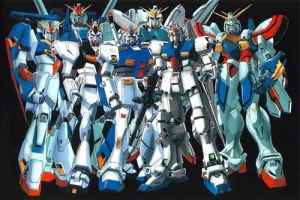
In the year Universal Century 0079 the Earth Federation is at war with a group of space colonies known as the Duchy of Zeon. When a small Zeon force happens upon the Federation’s secret weapon, the young Amuro Ray gets caught up in the war and ends up piloting the secret weapon: the Gundam.
GDT’s use of giant robots and the mecha are meant to pay homage to technology and confront the westernized fear of technological take-over that has been evident in films like Terminator or Eagle Eye. These films stress the importance of humanity overcoming technology, while the mecha genre stresses the importance of using technology to benefit society.
There’s no hint of a warning in the mecha genre, and it’s joyful, almost mythologizing of mechanical characters. These magnificent giant robots work on a mythical level. (Lambie)
While traveling in Japan to promote Pacific Rim, GDT openly admitted that one of his Jaegers – Cherno Alpha – was based off of the Gundam, MS-O6 Zaku II, and upon closer inspection we can see that other Jaeger models are based off Gundams. For example, the Japanese Jaeger Coyote Tango is based off of the Rx-77-2 Guncannon.
The Jaegers are like Gundams in which their weaponry are secured in reality and are – at least – plausible. They were built to match the proportionate size of the Kaiju and with the intention of avoiding nuclear warfare. They generally rely on close-combat abilities and can utilize swords and blades to fight. They also wield heat-based weapons to damage and cauterize the Kaiju’s wounds in order to minimize the spread of the Kaiju’s toxic blood. Unlike the Super Robot genre, the Jaegers weapon designs are practical. They are designed to minimize damage to civilians and cities, and the pilots are trained to do the same. In the first episode of Mobile Suit Gundam alone, Amuro Ray recognizes that blowing up the enemy Gundam would destroy the colony, and he decides to aim for the cockpit. Lessening the damage to cities and civilian harm is reflected in how the Jaegers are deployed from their respective Shatterdomes into neighboring harbors or oceans.
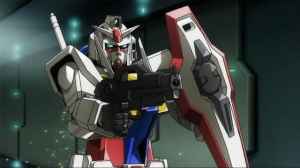
By basing a lot of the Jaegers abilities in a down-to-earth reality as Gundam does, Pacific Rim manages to make a very “big” film feel very real. The Jaegers are not entirely overpowered, and piloting a Jaegers takes much more than “spunk.” GDT secures Pacific Rim in its own horrible reality that comes with war. When the audience learns that Raleigh Beckett was still connected to his brother in the drift when he died, we become very aware of how important each, and every action is. In a world of monsters, there are no superpowers, only the capabilities and character of the individuals really come into question. In the first few episodes of Mobile Suit Gundam, Amuro Ray has absolutely no idea what he is doing. He does not know how to pilot the RX-78 and only wins over the Zeon soldiers because the RX-78’s armor is stronger than they are used to. As the series progresses he must not only understand how to properly pilot the Gundam, but he must also understand the gravity of the power he wields. While facing off against Char “Red Comet” Aznable later in the series, he accidentally kills the girl he loves, Lalah Sune. The concept of loss is extremely prevalent in Pacific Rim and it gives each and every character a reason to fight.
Raleigh Beckett must fight in honor of his dead brother, but he must first overcome his fear of the drift. Mako Mori must fight because she lost everything she knew and loved when she was very little and, had it not been for Stacker Pentecost, she would have had nothing to live for. At the same time, Stacker Pentecost sacrifices himself for the girl he raised from the ashes of war.
We’ve been able to draw fair comparisons between Pacific Rim and a variety of mecha anime without claiming that GDT is plagiarizing. However, nothing is entirely original in today’s world. If one has a broad knowledge of anime they can easily make even more comparisons between the film and anime.
Other Similarities with Anime
There are a variety of anime that can be considered “inspirations” for Pacific Rim. For example, it is common in anime for male characters (sometimes female) to receive blood noses and/or faint when in shock or highly aroused. In Pacific Rim the blood nose issue appears although it is of a result of Penecosts medical issues.
Another small comparison one can draw between Pacific Rim and NGE is the mecha series, RahXephon (2002) by (Wolf’s Rain, Fullmetal Alchemist). Here, Ayato Kamina uses his mecha to fight an alien race known as the Mulians. These enemies are shrouded in mystery for the majority of the anime, although one identifiable feature they have is blue blood. It is probably completely coincidental that the Kaiju in Pacific Rim also have blue blood. The series is often criticized for being an “Evangelion rip off” due to the similar plot set up of Ayato having to protect his home city, and the basic roles each of the characters play. The story, characters or their relationships have little resemblance to Pacific Rim, however.
Despite the hundreds of mecha anime that have been produced in Japan, this article is not meant to downplay the efforts of the creative team. That being said, the comparisons have yet to end. There isn’t any anime compared to Pacific Rim as much as Neon Genesis Evangelion.
Neon Genesis Evangelion
Hideako Anno’s 1995 anime, Neon Genesis Evangelion (NGE) is about a young teenage boy named Shinji Ikari that is recruited by an organization named NERV to control a giant cyborg called an Evangelion [Eva] to fight monstrous beings called Angels. Evangelion takes place in a post-apocalyptic world that unites mankind against a common, alien enemy.
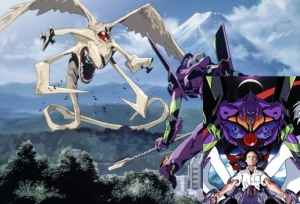
The common features between NGE and Pacific Rim are few and far between. The pilots protect their island from monsters, but this is something that is covered in a large number of mecha anime that both came before and after NGE so it is hardly something unique to that title. For example, Hideaki Anno also worked on the Gunbuster OVAs (1988) which involve a bunch of female mecha pilots that protect their planet from invading insectoid organisms. Kishin Corps (1993), Ariel (1989) and Voltes V (1977), amongst many others, also involved protection from an alien invasion. Very close to Pacific Rim, the television series Blocker Corps (1976) actually involved an army of people and monsters rising from the sea to attack Japan! Examples of titles that came after NGE that utilize this plot setup include Fafner (2004) and Rahxephon (2002). The rainbow synchronization computer and the idea of “synchronizing” with your pilot is only explored in episode 9 of NGE “Both of You, Dance Like You Want to Win” (Shunkan, kokoro, kasanete).
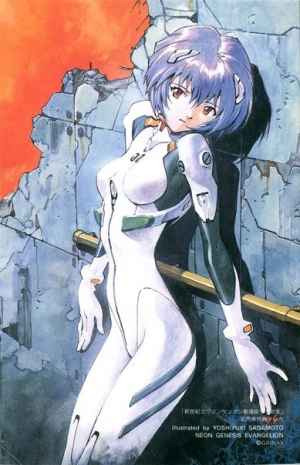
Fanatics have even gone so far as to note that Mako’s haircut was taken from Rei Ayanami from NGE. Besides the short length of her hair this seems coincidental. A stronger comparison in terms of appearance would be between Mako and Knives Chau from Scott Pilgrim Versus the World. If anything, at least Knives has the strip of blue hair.
The laid back nature of Rei’s character has also been quoted as similar, although this is more likely to reflect the politeness in Mako’s Japanese culture. Rei is still learning about the world as she was created by Gendo as a clone of his deceased wife. Her quietness is more out of introversion and her lack of a born temperament. Appearance and mannerisms out of the way, there is still one area where Rei has some link to Mako’s character.
The relationship dynamics between Mako and Stacker Pentecost is very similar to Rei Ayanami and Gendo in NGE. Gendo is the main founder and commander of NERV, and Pentecost seems to share a very similar role within his organization – as Marshall of the Pan Pacific Defense Corps. Pentecost was the first to test out and back up the Jaeger Project. Pentecost adopts Mako out of sympathy for her loss of her family, and acts as a guardian for her. Despite this there are distances between them as Pentecost does not initially allow her to become a pilot. These two links between franchises are still very different. Mako is not a clone. She respects Pentecost because she was adopted, rather than because she was created. Mako and Rei do eventually stand up to their guardians. For Rei it is not until the film, The End of Evangelion.
The last character comparison I will make against NGE is, surprisingly, one of the side characters. Newton Geiszler has a lot of personality traits in common with Kensuke Aida from NGE. Newton in Pacific Rim acts as a researcher for the Jaeger Program to determine the origins of the Kaiju and how to defeat them. Kensuke is Shinji Ikari’s friend. He is a military buff and an obsessed anime fan (otaku). He is also oblivious to the difficulties of Eva pilots. Despite their age differences, they both share similar physical features. Each character wears glasses, and like to wear a white shirt: Kensuke and Newton.
This would seem just like an interesting coincidence if it wasn’t for the shared personality traits. Both are extroverts, like to joke around, have obsessive levels of passion for their chosen area of interest and talk extremely quickly. They both put themselves in danger in order to learn more about their trade. One could see Geiszler as a grown up version of Kensuke. Again, this is merely a coincidence but an entertaining one.
Broad comparisons between Pacific Rim and anime like Evangelion is entirely harmful to the film and the filmmaker’s integrity. GDT was not looking to plagiarize from the mecha-anime genre. As it goes in today’s cinema, nothing is entirely original. Instead, an assortment ideas are taken and made into something new. GDT is quoted saying:
I’m not reflecting on any other summer movie so much as I am honoring two things that are crucial: the kaiju and the mecha. Japan, unlike any other country in the world, I think, does not have any ambivalence against technology.
Instead of taking to the streets with righteous cries of “plagiarism!” We should accept Pacific Rim as a standalone film that pays tribute to the mecha genre that we love. It still stands alone as a film with its approach to controlling the mechas, and the designs of the Jaegers and Kaijus. The characters each developed in such a way that we passionately root for them to win over the Kaijus and the action sequences are breathtaking enough for us to appreciate the film and come back wanting more.
This is a joint piece by Jemarc and Jordan.
Works Cited
Dragmeist. “Dragmeist Delves: Tetsujin 28 – The Father of Japanese Giant Robots.” Fantomzone. 17 Jul 2013: n. page. Web. 15 Apr. 2014. <http://fantomzone.org/dragmeist-delves-tetsujin-28-the-father-of-japanese-giant-robots/>.
Lambie, Ryan. “Guillermo del Toro interview: Pacific Rim, monsters and more.” Den of Geek. 12 Jul 2013: n. page. Web. 13 Apr. 2014. <http://www.denofgeek.us/movies/pacific-rim/151973/guillermo-del-toro-interview-pacific-rim-monsters-and-more>.
Schaefer, Sandy. “Guillermo del Toro: ‘Pacific Rim’ Is NOT Japanese Monster Movie Homage; No 3D.” Screen Rant. N.p., 15 Feb. 2014. Web. 11 Apr 2014. <http://screenrant.com/guillermo-del-toro-pacific-rim-japan-anime/>.
What do you think? Leave a comment.











I found the movie to be it’s own thing. While certain shots, or designs may be reminiscent of Evangelion, Gundam, or the Godzilla movies…this really reflects the creators’ homage to the genre, not of one particular film or series. It has it’s own mythology, it’s own “rules”, and it’s own story. Yes, the story is derivative (there are supposed to only be 7 stories…period…everything else is just the dressing, so that can be forgiven)…and yes, the characters are a bit cliche…but the writing was good enough that you overlook it’s faults, and just strap in for the ride!
So great article.
It is a genre film, you’re able to draw a lot of parallels, and design overlap is always going to happen. However this was a great presentation of influences.
Pacific Rim is more like a straight forward robot vs. monsters film, much like the mecha anime from the 1970s and 1980s. There’s no pretence of robots being more than just fighting machines. There is no greater stake than just defeating the monsters.
Evangelion on the other hand is like a psychoanalysis transfigured in an animated medium. Every scene tries to say something. There’s always an extra layer to “robots” pummelling monster scenes.
The people who keep making this comparison keep forgetting about the decades of history behind giant monsters and giant robots. It is not that Del Toro is ripping off Evangelion, it’s that he’s paying homage to these truly venerable creations.
Most of it is snobbery, and ignorance, and some of it is actually just viewers being excited about the movie and comparing it to the example they know best. Some of the comparisons aren’t malicious though. I know quite a few people who were excited about Pacific Rim because they thought it looked like NGE.
I watched pacific rim without knowing anything about the comparisons to the nge series but only after a few minutes of watching the movie I was reminded of nge. The people who made this movie may deny it but I have no doubt that this movie was based on nge. They may have made a few changes to the story here and there but the structure of this movie was most definitely based on the anime series. Hollywood ran out of original ideas years ago. This isn’t the first time something like this happened or will it be the last time. Mecha stories are a dime a dozen in animes but there a few details in this movie that are too alike to the nge series to dismiss as a general comparison to all mecha animes. The director did a good job altering those details just enough to avoid possible legal problems.
Evangelion has lots of hearth and humanity… Pacific Rim lack in this area… it is surely a great movie but in the end is just spectacular, that´s all, nothing more nothing less, lot of effects and cool editing, but no hearth. I think people`s real complaining is that a new story with these kind of concept always had to be better, and Pacific Rim didn`t make it in my opinion.
So what about the similarities in the plot? The series’ major plot points follow kind of similarly in the film (until the end). Four different mechs, star kid whose father runs the program, bonding with their mechs. The guy basically took it all from that.
How about the competition between countries to bring the best Mecha. When they present the chinese robot as being the most High-tech (China, USA’s main competitor as an economy), just like the German Robot in NGE (Germany the engineering competition of Japan back then), oh and the Robot is all red too BTW! No one else felt like some kinda deja vu? And the fighting scenes are so similar.
I would have let it go, but Del Toro was working with Peter Jackson on the Hobbit, before he got fed up with the delays. Something that most people dont know is that Peter Jackson had been working on concept art for an Evangelion movie for ages. Seems like a good way to get back at Peter for taking so long would be to lift one of hi future project and give it a different coat of paint. Too many coincidences… but who cares, PR rocked.
Kind of related but the neural interface concept had been used in American animation before NGE. There was an American cartoon called Exosquad that predates NGE by about two years. Although the “mechas” were much smaller in scale, they still had a neural interface along with other controls. I’m sure the concept is even older still.
Very nice article. In reality, NGE and Pacific Rim and many of these animes are riffing on the same source material, and are both homages to the genre, so it’s no surprise there are similarities.
Pacfic Rim acting is the absolute worst I’ve ever experienced..it’s a video game made into movies for 5 year olds…
You don’t go to a movie like Pacific Rim expecting good acting. If that’s really what you wanted to see then you missed the point completely. You should have known, full aware from the trailers what you were walking into: a good old-fashioned, giant robot vs giant monster roller coaster. And boy, did this film deliver. Its pure fun from start to finish, molded for adults who have pleasant childhood memories of giant robots and monsters.
Plus, like the other guy said, Idris Elba was fantastic. Then again he’s always fantastic.
I would agree. You have to manage your expectations with a movie like Pacific Rim and realize what you are in store for before you go see it. If you expect Oscar winning acting performances instead of visual-action porn, then you will inevitably find yourself sorely disappointed once the credits roll.
Eureka Seven is also a great mecha anime!
Yes, agreed!
giant, multi piloted robots fighting giant monsters? Sounds like power rangers. This is an old idea. I think the movie was ok, but the anime theme was distracting, unnecessary and alienated the bulk of the target market. *NEWS FLASH* More people DON’T watch anime than do. For all it’s special effects budget, the robots were slow, clumsy, fought mostly with ineffective punching, and towards the end, began wielding swords that they had all along, but just never thought to use. Fun for the kids, but the glaring plotholes, anime clothing/haircuts, & the unimpressive acting will leave serious movie-goers wanting. Subpar work, Mr. Del Toro.
There are many great animes if you like Pacific Rim like:
Kakumeiki Valvrave
Neon Genesis Evangelion
Suisei no Gargantia – This one begins with many of mecha but he get trapped in a blackhole and is separated from his group. He gets transported to a place where it is only him and his mecha fighting things. Very cool. You will just have to watch.
Add these:
-Heroic Age
-gin Iro no Olynsis
-Muvluvf Alternative Total Eclipse
-Star Driver Kagayaki no Takuto
Let me break down a few things about the discussion about similarities between NGE and Pacific Rim.
1. They both feature giant robots. Contrary to popular believe mecha in NGE not a mecha, it is an organic born from 1st generation of angel. And you you really follow the manga/anime you know that eva has a 99% human DNA. Therefore conclude that pacific rim = giant robot, NGE = a giant organic thing
And one thing, in NGE adults can’t pilot eva, only children
2. The giant robots were created to fight giant monsters. One more if you follow the manga/anime Angels aren’t send by aliens, they come for the prophecy of creating 3rd impact which brought by Gendo Ikari and Zeele themself. Therefore, pacific rim = vs aliens, NGE = vs a shadow organization that wants to purifiy world by using ancient power of dead scroll
3.The pilots link up with their robots through a neural interface. Yes it’s quite same but in NGE, the difference is one with liquid thing called HCL and the other’s not
4.The nations of Earth have banded together to stop the threat to humanity’s existence. Once again, no they are not. Eva does created in abroad but in NGE all funds to create eva not based on united countries, but from a shadow organization “zeele” which stands independent. And they (Zeele) are not to stop the threat but to create one to wipe all human kind in the world so that they can fill the new world with another kind (if you follow the manga/anime you know what the “other kind is”)
5.The world is governed by an obfuscating council of the nation’s leaders. i am but to agree, vaguely
6.The female lead has partially blue hair, kind of like Rei. same hair style girl with father complex, other than that those two (mako and rei) are not the same. One is created for the dummy system, the other is pure human
7. There’s one mecha that has that one, single eye, kind of like Unit-00. Once again it’s not a mecha and because of one-eyed giant therefore it’s the same? no. The color, the weaponry, the generation are hell a lot of different.
Once again, if you follow the anime/manga type-O gone berserk and cause a massive disturbance in nerv (resulting in Rei being injured for the 1st meeting with Shinji)
Conclusion: most people believe that NGE = pacific rim but the fact is they are hardly the same. And the most important part that people always forgot, NGE’s mecha is not a real 100% robot but more likely a giant man manufactured with cables and technology in order to be controlled by human.
i’ll let you know the spoiler. In volume 9 NGE, Misato finally knew that the armor within eva is not a real armor, it’s a restrain so that eva can be manually controlled, without it eva just gone berserk.
There are a lot of great scenes in PR that mirrored NGE, perhaps not even to the knowledge of the del toro or the writer but perhaps by some of their team as an homage, or less believably as coincidence. Number one when mako freaked out in her first link she targeted Marshall with the plasma canon through a glass window in a scene that looks eerily similar th reis berserk scene in the test chamber. Also the scene where he is fighting the winged kaijou he uses a battleship as a weapon very similar asuka doing the same thing (although she used it against the army) but her holding the battleship is an iconic image that I think they were paying homage to. I feel like the Russian mech also looked lot like the nuclear powered mech in Eva but it’s been a while so I might be misremembering that. Either way I think pacific rim was great and it at least has some fun EVA Easter eggs which seem intentional but if not then its a fun coincidence.
You were not joking about In-depth my friend. It’s rare you see someone take a topic with such zeal and passion. I’ll admit that I’ve never been big on Giant Robot anime, but your writing conveyed a sense of love and appreciation for all the various sub-genres that I had a moment’s pause in my thinking. On to Pacific Rim, again I avoid that movie just like I avoided the Transformers series. I may have to walk back my previous decisions.
Thank you! It wasn’t just me though, this article was co-written with Jordan =].
Really glad you appreciate the article 🙂 I found it very interesting to learn all of these facts s well.
How about Johnny Sokko and His Flying Robot?! 😀
Was not that original “mecha” anime, Mobile Suit Gundam, inspired from the power armour in Heinlein’s Starship Troopers?
To all fans of Pacific Rim, I’d recommend watching Neon Genesis Evangelion if you do get the chance. Everyone will not enjoy it but if you don’t mind extremely dysfunctional characters, some pretty confusing mind trips, and the cast getting dealt some pretty heavy trauma, it’s an outstanding series.
It is kind of to mecha anime what Watchmen is to superhero comicbooks. It’s a detailed deconstruction of the genre rather than an earnest celebration of it, like Pacific Rim.
For gods sake do NOT watch it when drunk or otherwise intoxicated. At least not the original series. Don not try to watch all of the episodes and Death and Rebirth and End of Evangelion back to back. Particularly when intoxicated!
There were many Japanese cartoons and manga about giant robots, but I believe Gundam was the first to present the ‘bots as simply vehicles, just extensions of the pilots’ wills, as opposed to individual machines with a distinct personality or identity of their own.
Pacific Rim borrows a lot from classic giant mech monster-fighting anime shows. In particular, Neon Genesis Evang was likely a big inspiration (it is also the show that Gurren Lagann is an artistic response to).
Oh well for the giant robots alone I’d state Gurren Lagann will do just more than scratch that itch. Thematically it doesn’t have any real connections to Pacific Rim but it has a lot of giant robots that just keep getting bigger.
I’ll be perfectly honest — I was one of the people who compared it to Evangelion, though more for the neural link thing than anything else. Other than that the similarity basically stopped at “giant robots fight extraterrestrials,” which as it is pointed out was hardly Shakespeare two decades ago.
The depth of this analysis was incredible. I applaud your dedication to this.
Wow. Shout out to you and Jordan. This is a very well-thought out, engaging article. Damn, I love anime and everything can do. I gotta go out and see Pacific Rim. But you guys really did do a wonderful job on this! Awesome, awesome and, dare I say, sugoi~
Thank you for the response Mary :D. I have watched Pacific Rim….a lot. Admittedly the acting really is not wonderful (except for Idris Elba, all hail) but I relate to the film on a very personal level. It reminds me so much of the anime I grew up both watching and being surrounded by that I cannot help but be drawn to it. PM me when you finally get a chance to see it, or maybe even comment on this again. I’d love to hear how reading the article influenced your perspective!
Arigatou 🙂
Having been familiar with Eva for over a decade, I was really on a high alert looking out for the LCL-like orange fluid in their helmets as glimpsed in the trailers. So when I was at the actual movie w/ my eyes peeled and that scene came out, I noticed (in 70mm IMAX 3D clarity) that the fluid was not inside the breathing space of the helmet but rather seemed to be draining from a space between two layers of glass that formed the face of the helmet. Kind of like they had a double-walled helmet glass and the fluid had been insulating those two layers of glass.
Good one! I did notice the fluid stuff and wondered what it was about, especially since it didn’t seem to show up again later (and the helmet design was incompatible with it being liquid breathing).
I caught Big O, G Gundam, and Betterman more than anything else. All of those references could have been on purpose or accidental but it didn’t matter to me, it just showed that with movie magic a fan boy can hope for those movies.
I’ve never seen “Evangelion” is it any good? I’m not a hardcore anime fan but I did watched some in my day. Anyone remember Dr. Slump, Saint Seiya and Dragon Ball?
Evangelion is more about the characters then the fighting robots, but that’s why many people love it.
I would recommend watching the 2007 first remake movie, then continue on from the series at episode 7 (I think it is) if you llike it. Its pretty much the same material.
Evangelion is a great anime, though towards the end of the original series, it goes really deep into philosophy and other topics. They are releasing two hour long movies, retelling the original series, but the original is still slightly better (though the angels in new Blu-rays are amazing).
If you like mecha anime Rahxephon, Gurren Lagann, Code Geass are good. Bit hard to recommend anime without knowing what kind of films you like as there are so many different genres of anime.
Anyone watched Ultraman? There aren’t any giant robots but there are giant monsters and they’re absolutely awesome!
Heard of it, haven’t seen it!
I’m going to recommend RahXephon!
Speechless. Very nice research!
As someone who, after watching Pacific Rim and Evangelion was positive that the film was heavily informed by the show, I was very intrigued by your article. It was very well written and researched and it broadened my knowledge on both anime and what it means for a film to be in a particular genre.
I have a lot of thoughts on this subject, and I’m sort of surprised by the amount of “pontificating” in the comments section, but all the praise is well deserved, Jemarc and Jordan!
Really fantastic article here, very polished. It makes me happy that people will read this and try watching Eva ; )
Thank you Nilson! =]
Thanks. 🙂 I’m just hoping they read the whole article. Some of these comments seem to be regurgitating the material so I’m not sure! ha ha
I strongly felt the director must watch Japanimation before such as Evangelion, Gundam or Gunbuster and etc when I saw Pacific Rim. I do not think the director intentionally referred any specific animation but he might get affected by what he already saw.
Anyway, I loved this movie. The director pulled up this movie with something new than the other hero marvel comics movies. Evangelion is great in many ways and I was huge fan of it. However, the story line is blurry and little hard to follow the feel and emotion of the main characters. I am glad that Pacific Rim creates own story and cut deep complication out for audience.
I hope there will be more films like this move which are blended with plot style from Japanimation and Hollywood effect and story.
I won’t lie…I was hoping for a Saikano reference. I’ll…just see myself out now.
Saikano gave me all of the feelings. Although in regards to the “mecha” genre I would argue it deviates from that into its own genre.
I like Saikano, but it doesn’t really relate to Pacific Rim much at all.
Pacific Rim, on its own, was and is a great film. Sure, it doesn’t do anything innovate, and the characters don’t necessarily add anything extraordinary, but boy, was it an action-packed, exhilarating action fest.
I haven’t seen Pacific Rim, yet, but I could not escape its comparisons to Neon Genesis. I really liked that you explored other aspects of its influences. Very in depth and very cool. Lovely!
Pacific Rim was a love letter to all things badass and explosive and awesome, taking inspiration from Mech Anime, giant monster movies, and even Michael Bay if i may be so bold. i had a friend who thought it a souless mockery of Neon Genesis Evangelion, but i can separate it from all the things it takes inspiration from. and although it is heavily influenced and makes many nerdy references, i believe Pacific Rim can stand on its own. it was a FUN movie, which many blockbuster summer action movies tend to forget to do these days, theyre too caught up with visuals that they don’t take time to care about story or characters. this movie had great visuals but it also had great humor as well. overall Del Toro did a fantastic job and i look forward to seeing more films like this (cough cough Godzilla cough)
Really nice, informative, well-researched article. Made me want to watch a lot of those old animes because I loved Pacific rim.
Holy crap. An extremely well-researched an in-depth article. Really amazing to read. I loved Pacific Rim and watching Escaflowne growing up as well as some of the Mecha-animes they showed on Adult Swim at 2 am, I was super excited for when it came out. Thanks for all of this!
No worries really glad you got something out of it. Its what we write for 🙂
I really like that you gave such a thorough analysis, provided background on your comparisons with other Animes like Evangelion and addressed the associated rumor mills as well. And also thank you for cutting down the time for people like me who would eventually have had to research all these things to get a clearer picture on all this fuss
Hey, nice article. Though I’d like to (quite pedantically) point out the erroneous use of the term Gundam in the following instance, “…Amuro Ray recognizes that blowing up the enemy Gundam would destroy the colony…”, the mobile suit in question was in fact a Zaku II. For future reference, all Gundams are mobile suits but not all mobile suits are Gundams.
As for Pacific Rim’s mecha anime inspirations I’d add Big O and Dai-Guard to the list. (Perhaps even Giant Robo to a lesser extent.)
I am super impressed by this joint work. I have to admit that hearing the perspective of a person who grew up (and thus understands) Japanese culture was . . . enlightening.
Another thing I’ve noticed about many Japanese anime and/or manga is that there are undertones of the religious perspective of the Asian culture, which has been heavily influenced by Buddhism, Shinto [in the case of Japan] and Hinduism.
Some examples I can think of are:
*Naruto
*Sailor Moon
*Kodomo no Omocha (manga only)
In Naruto and Sailor Moon, reincarnation plays an important role in the destiny of the main characters [Naruto as the reincarnation of Ashura, the Sage of the Six Paths’ youngest son; Sailor Moon on the basis that Serena/Usagi is the reincarnation of the Princess of the Moon]
The manga Kodomo no Omocha refers to religion briefly through the character Fuuka, who is a Christian and thus, a religious minority among her peers.
Overall, great job.
I loved Pacific Rim and the newest version of Godzilla (haven’t seen the original yet) and I can see the similarities between the two. I can’t really relate PR to any of the other anime mentioned because I haven’t seen those either. Besides that, I enjoyed this article 🙂
The influence of anime on our culture has been there for some time. However, it’s presence has been more subtle. Films like the Matrix are examples of this. This film is a bigger step for anime-related products in mainstream western culture.
This film is a bigger example of anime related products influencing western cinema. There have been subtle aspects over the decades but this one is a huge leap forward.
One thing I hate about all the comparisons to NGE is that people seem to be oblivious to the fact that mecha movies are an entire genre in anime. Numerous properties involve giant robots. So saying Pacific Rim is like NGE is like saying The Dark Knight is just like Catwoman just because they are both superhero fims.
In film, just like books, people build this library in their minds to see what works in a story and what doesn’t.
I really enjoyed this article as I got a crash course in anime, yet love the interplay between those works and Pacific Rim. Personally I enjoy the film, and it does have a huge fan base on sites like Tumblr. Here’s hoping GDT makes that sequel.
An excellent article.
Though a good analysis of the film and its inspirations, much of the content was unneeded. It was not essential to mention every possible inspiration when Del Torro himself denied a correlation between his film and particular series. A good attempt though, I particularly find all the anime and movies mentioned and I adore the universe of Pacific Rim. Pray the sequel eventually gets made.
Here’s a few Pacific Rim details I noticed that closely match NGE.
1. PR: At deployment time, robot head moves rapidly on rails through vertical shaft. Action is loud, sudden, and dramatic. NGE: At deployment time, entire robot moves rapidly on rails through vertical shaft. Action is loud, sudden, and dramatic.
2. PR: Helmets visibly fill with some kind of fluid (obviously not affecting pilots breathing–appears between outer layers of glass). NGE: Helmets visibly fill with some kind of fluid (a big deal is made out of fact that they are breathing it).
3. PR: In a large mission control multi-workstation room, staff monitors progress of power-up and reports on quality of drift and synchronization between pilots and their robot. Special mention is made when our main heroes appear to register high on the drift quality scale, so we know this team was meant to be great. NGE: In a large, mission control multi-workstation room, staff monitors progress of power-up and reports on quality of synchronization between pilot and Eva. Special mention is made when our main hero appears to register high on the synch quality scale, so we know he was meant to be great.
4. PR: The female, blue-haired Japanese pilot loses control of her emotions, letting instinct take over. Dramatic contrast and camera angles emphasize huge threat of robot’s arm powering up and pointing at several people on a balcony, while to the side is the glass-fronted control booth, situated high off the ground, closer to the head height of the robot. People start evacuating the control booth while desperate measures are taken to cut power. But it takes a long time to finally cut the power, as tension builds and the threat looms greater. Both before and after this scene, mention is made of the female pilot’s lack of discipline and emotional control. NGE: The female, blue-haired Japanese pilot loses control of her Eva, whose instincts take over. Dramatic contrast and camera angles emphasize huge threat of robot’s fists slamming into the glass-fronted control booth, situated high off the ground, closer to the head height of the Eva. People start evacuating the control booth while desperate measures are taken to cut power. But it takes a long time to finally cut the power, as tension builds and the threat looms greater. After this scene, allusion is made to the possibility that the female pilot was emotionally unstable and/or possibly the cause of the Eva’s reaction.
5. PR: The robots are the size of skyscrapers, often seen running through a tall cityscape, inevitably smashing into buildings. They wield objects like massive container sea vessels like toys. During deployment, they are often seen being transported by air, suspended from cables. Many 1st tier industrial countries have pooled their resources to manufacture these robots, yet each country seems to have their own unique designs. Budgetary pressure is always felt, and when a robot is lost, everyone knows a replacement isn’t likely. NGE: F’ing ditto.
Of all the anime giant robot series, NGE was a milestone in taking it all seriously, showing much more realistic (and awe inspiring) contrast of size, much more realistic nuances in the technical support area, and of course a darker emotional impact on the individual pilots themselves (the latter being the main thrust of the anime, or at least its MO). Naturally, this will place NGE closer to the mark achieved by a live-action film such as PR. That’s not to say that PR isn’t its own, unique blend of elements in a very nicely executed realistic backdrop.
Having said all that, the similarities between PR and NGE are more than just the imaginations of a few anime fanatics. At the very least, the coincidences–particularly the multi-element orchestrations that coincide simultaneously on so many points–are hard to accept as mere coincidence.
Correction to previous comment. Obviously the Eva pilots don’t wear helmets. The capsules fill with fluid.
Is there an edit button?
I had read this particular article sometime in mid-2015, and having seen the movie and being familiar with (but not knowing entirely) the anime and manga that you have mentioned in your article, I can see why the movie itself had aspects of anime being used – The Japanese girl having a flashback (a trope in anime), the ending scene as well as the detail to gore (something which is common in mecha anime and cannot be overlooked), and the names of the robots and monsters (Kaiju vs. Jägers – the latter is something which is a byword that is not used so often, but is clearly still a mecha sounding name). I don’t have much to critique in your article, because it provided insight into the mecha genre and how this movie was a tease and a tribute to the mecha genre while standing out on its own as a decent movie (I certainly thought it was a decent movie at any rate).
All in all, a good article.
I saw a b movie at a drive in around 1970 ish. It featured two super robots piloted by a good guy and of course a bad guy. Each controled the robot by standing in the head. That’s all I can remember, it was shown at a drive in, and I was with a girl, enough said.
Really well written, and structured. It’s a shame that Hollywood isn’t taking enough chances in anime-inspired films – despite certain backlash of those they have done. It’s time the era of the sequel died out.
To me, anime is one of the most influential forms of pop culture in the world. It can be hard and even painstaking at times to create a live-action film based on anime like the recent “Ghost in the Shell.” It is better to draw influence from anime rather than adapt them.
There’s a biological term called convergent evolution…where animals of different classes, orders or families and so on evolve the same features to cope with their environments…how both sharks and dolphins have fins to swim and how both bats and birds have wings. Apply this same logic here. Kaiju from Pacific Rim and Angels from Neon Genesis Evangelion are both types of large monsters posing a threat to humanity, and as humans are small and pathetic in comparison, large humanoid machines controllable by humans seem to be a good answer. Jaegers weren’t meant to copy the Evangelion Units, they were created to fight their universe-specific monsters.
And saying that all instances of mecha occurring across different works were inspired the very first one…that’s like saying the iPhone was inspired by the invention of Alexander Graham Bell.
take a look at a 2013 comic called “Tokyo Storm Warning” by Warren Ellis – VERY similar concept
The perception tendencies of Japan and the West in terms of mechanical technology are almost diametrically divergent (i.e., Japan: Robot=good; West: Robot=bad).